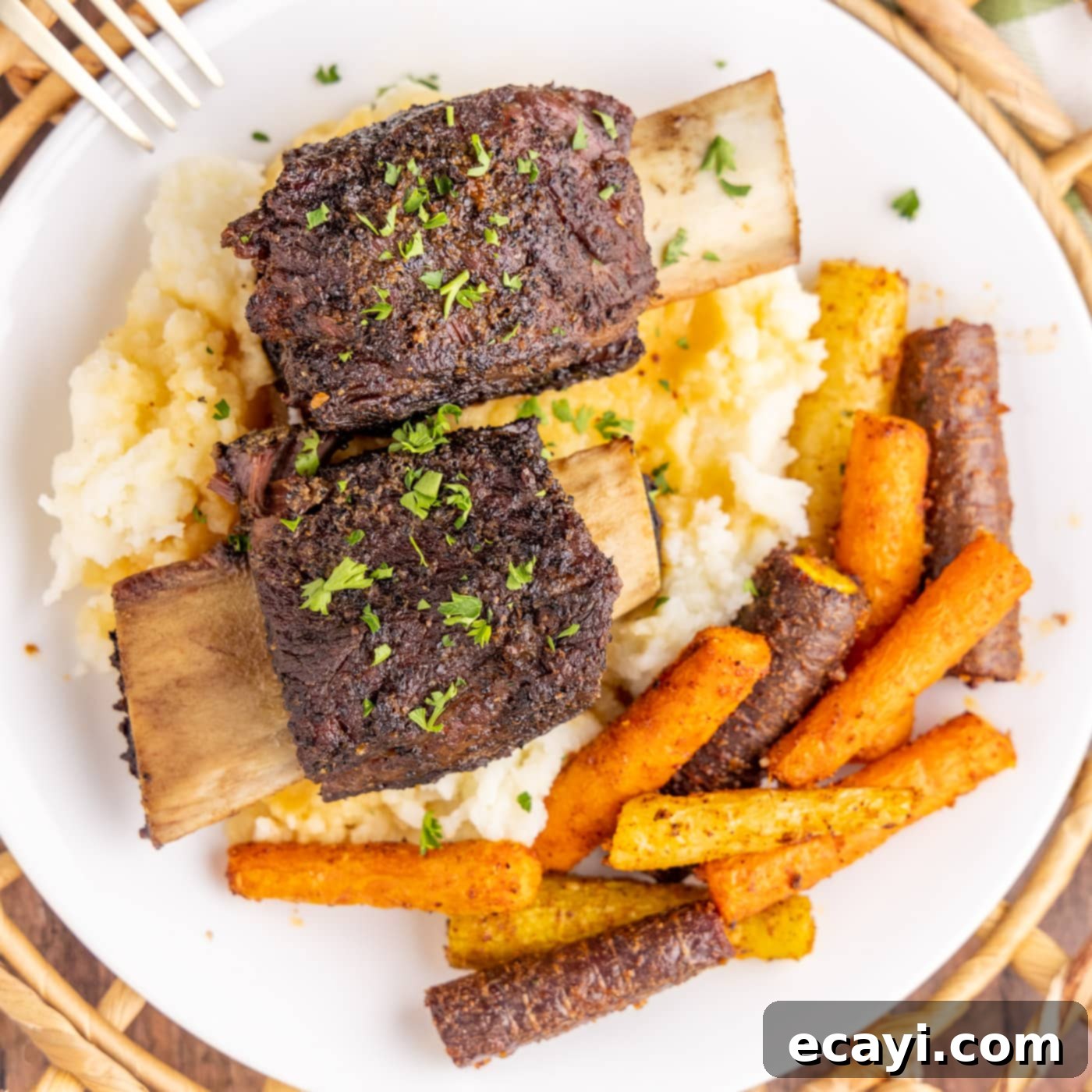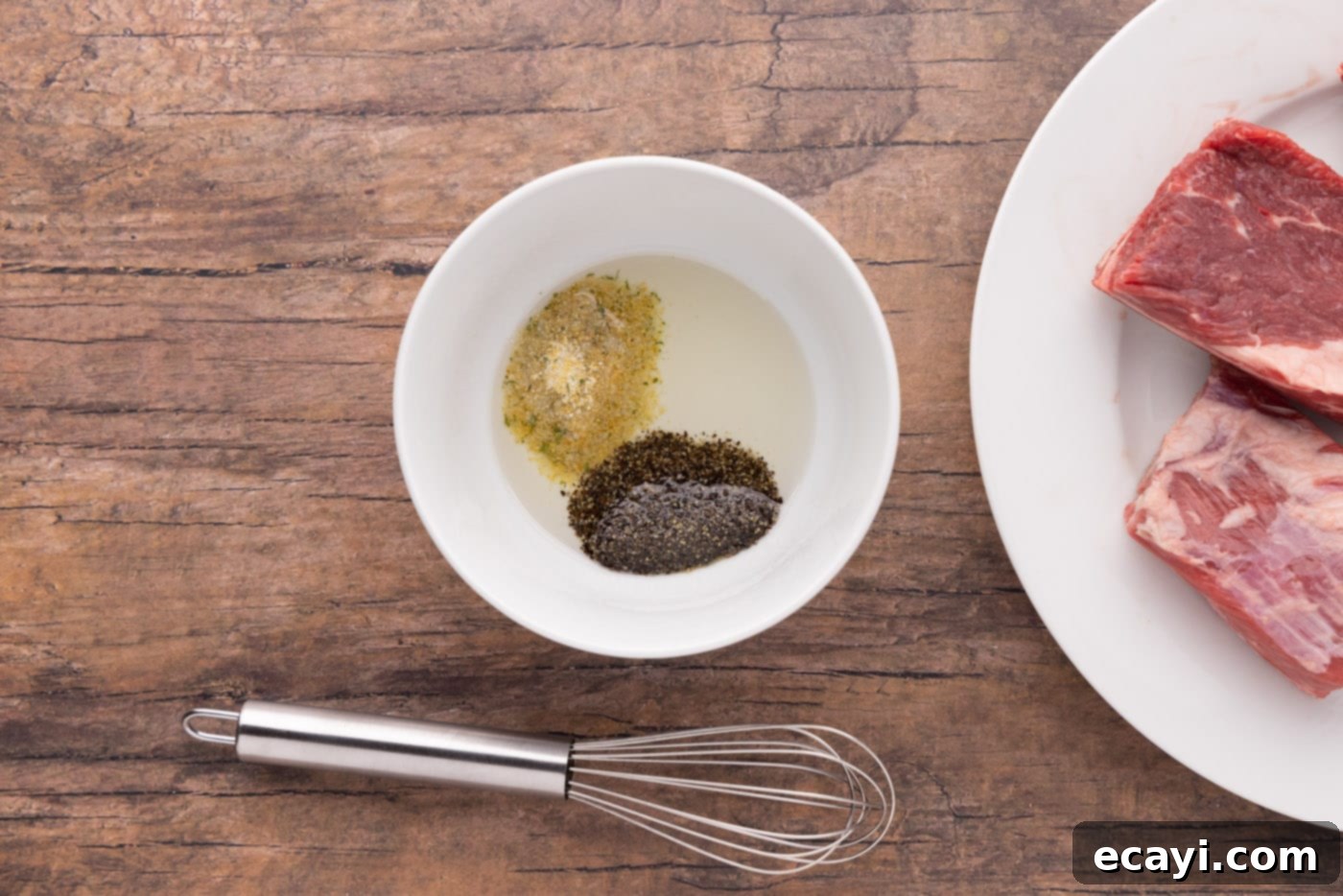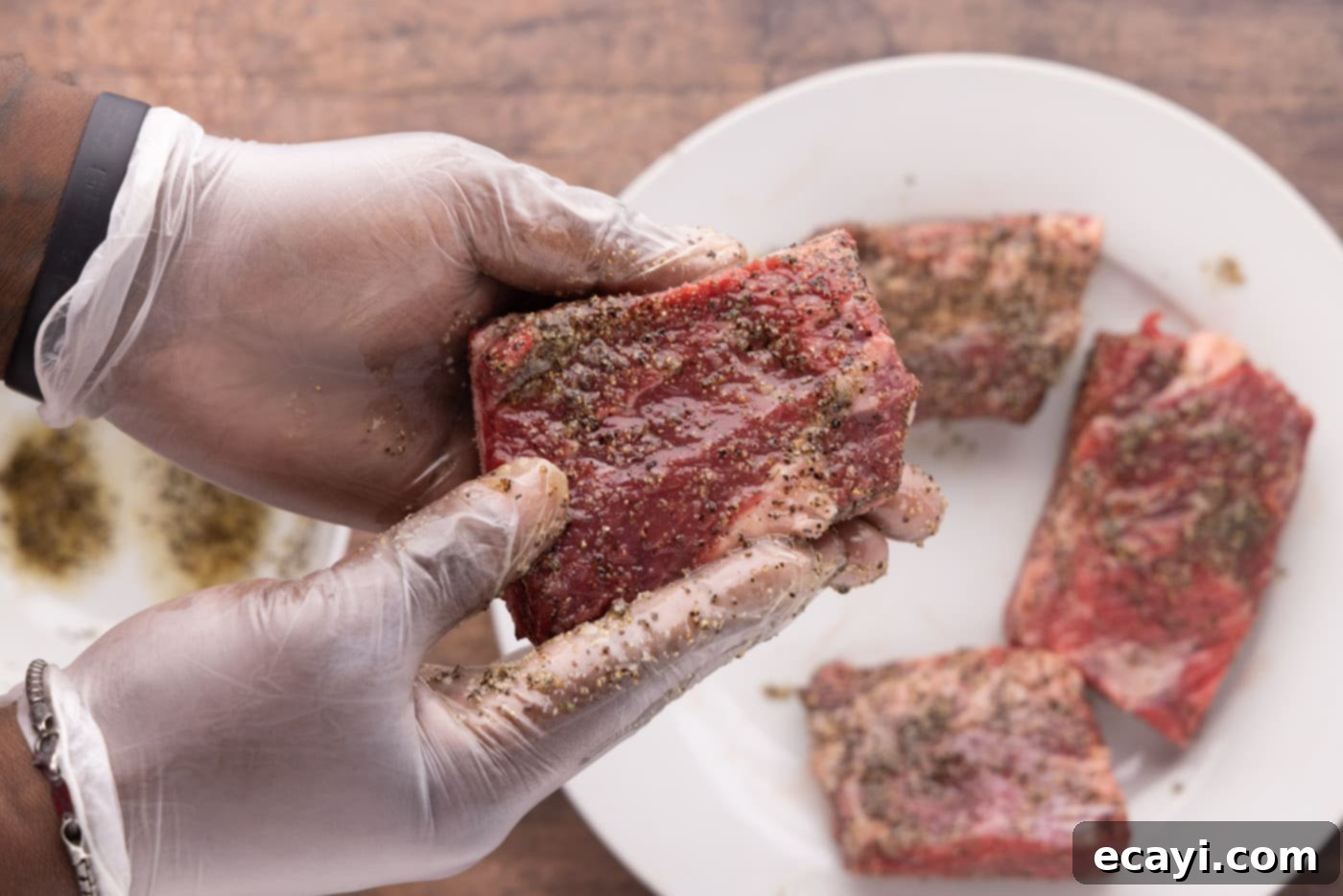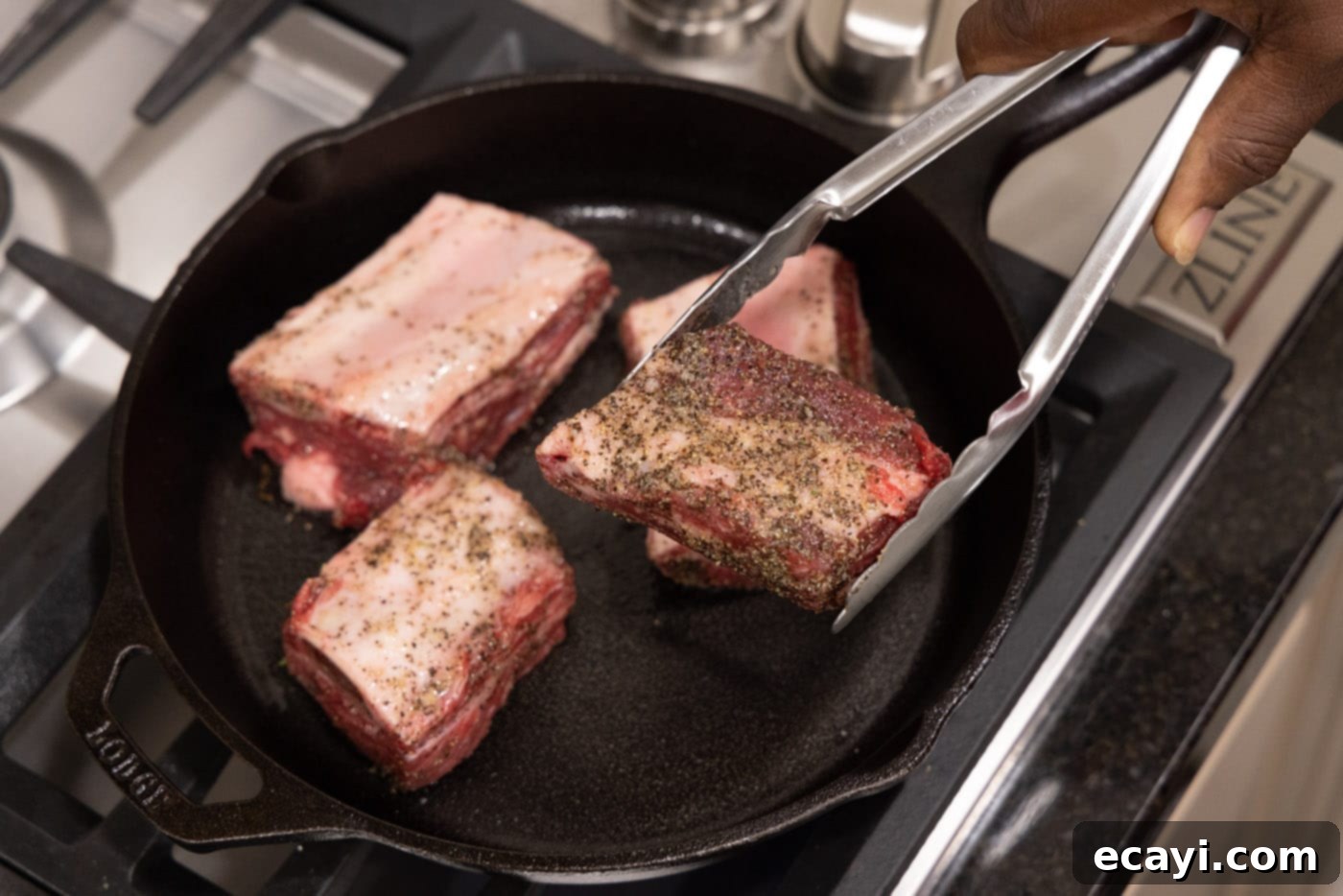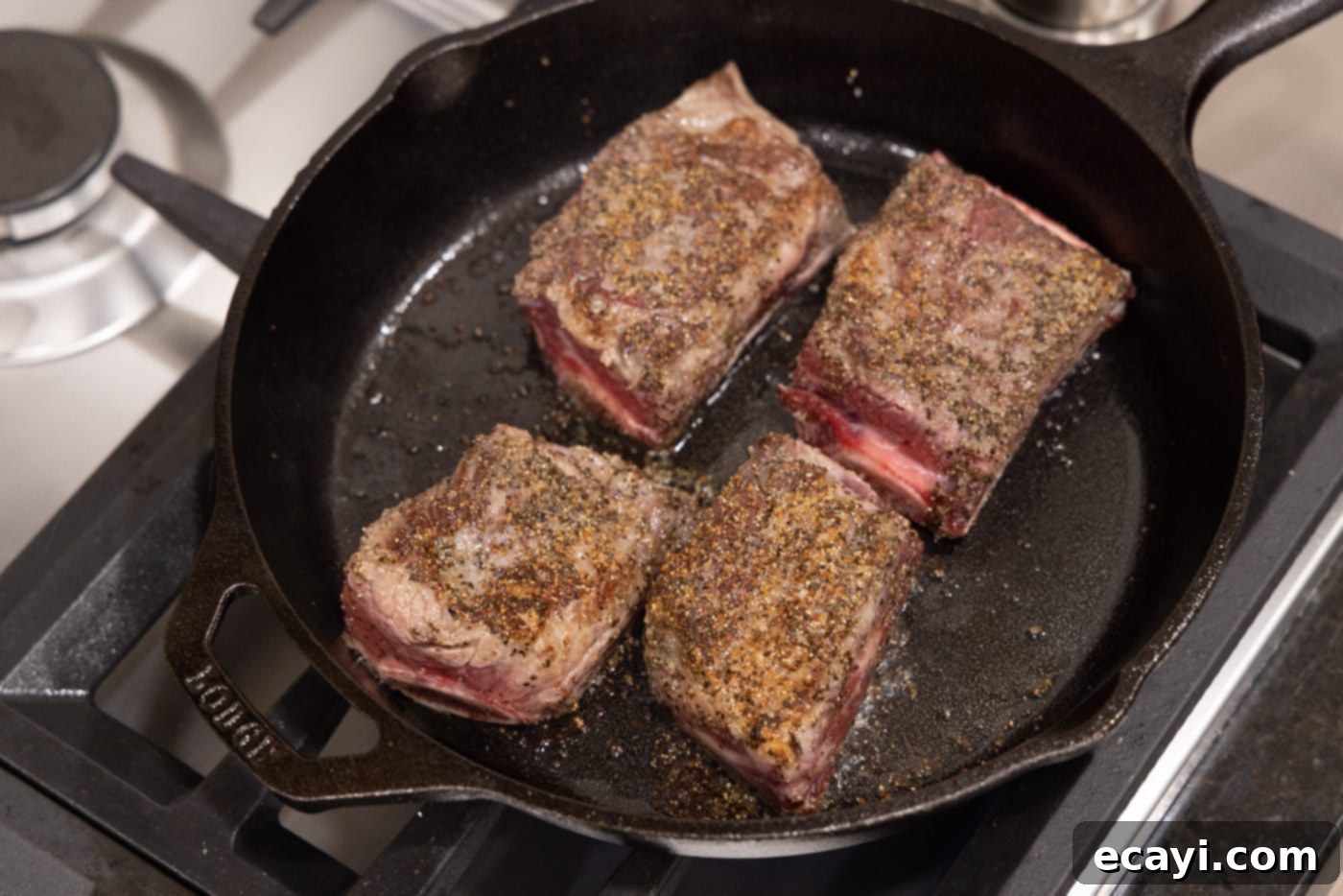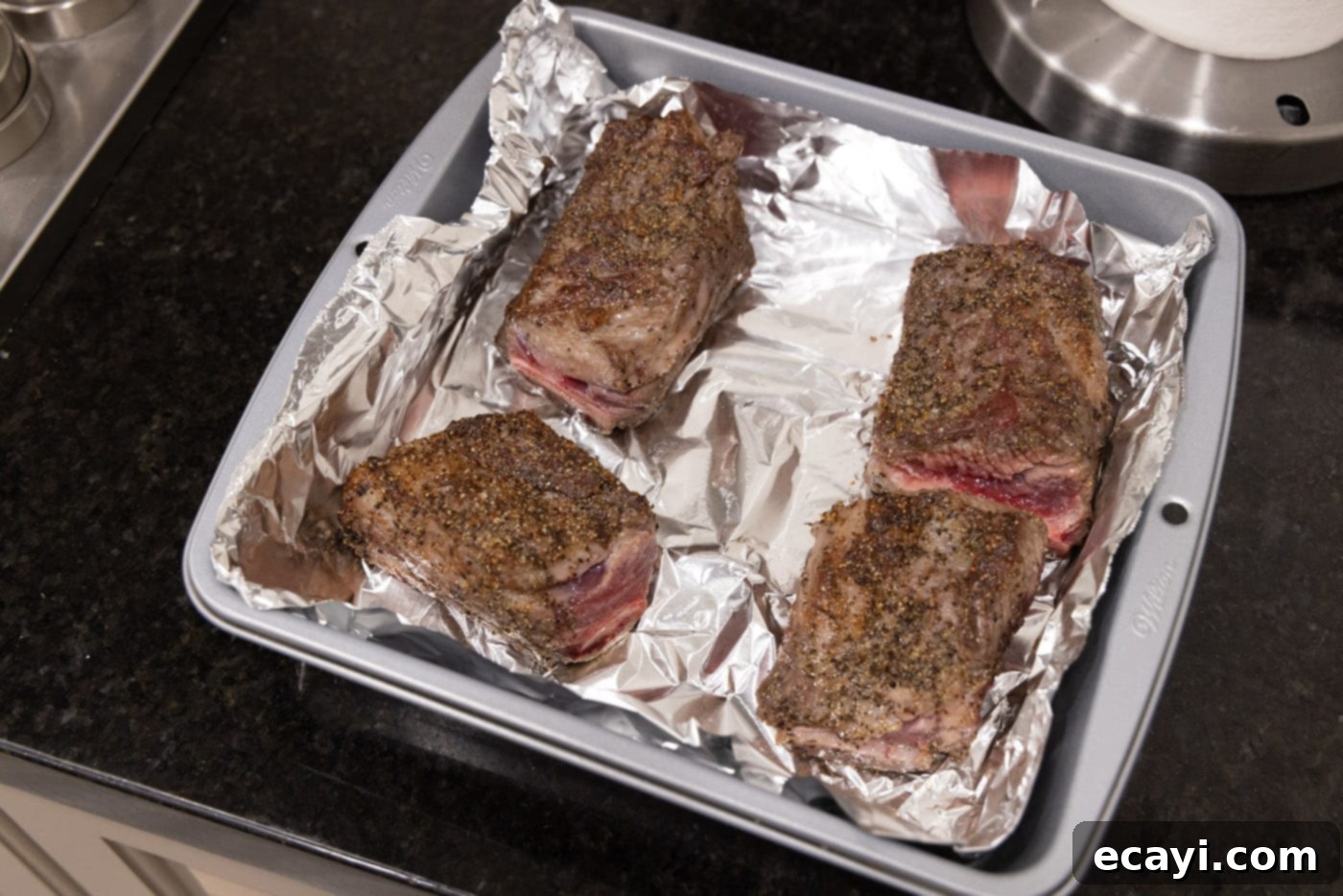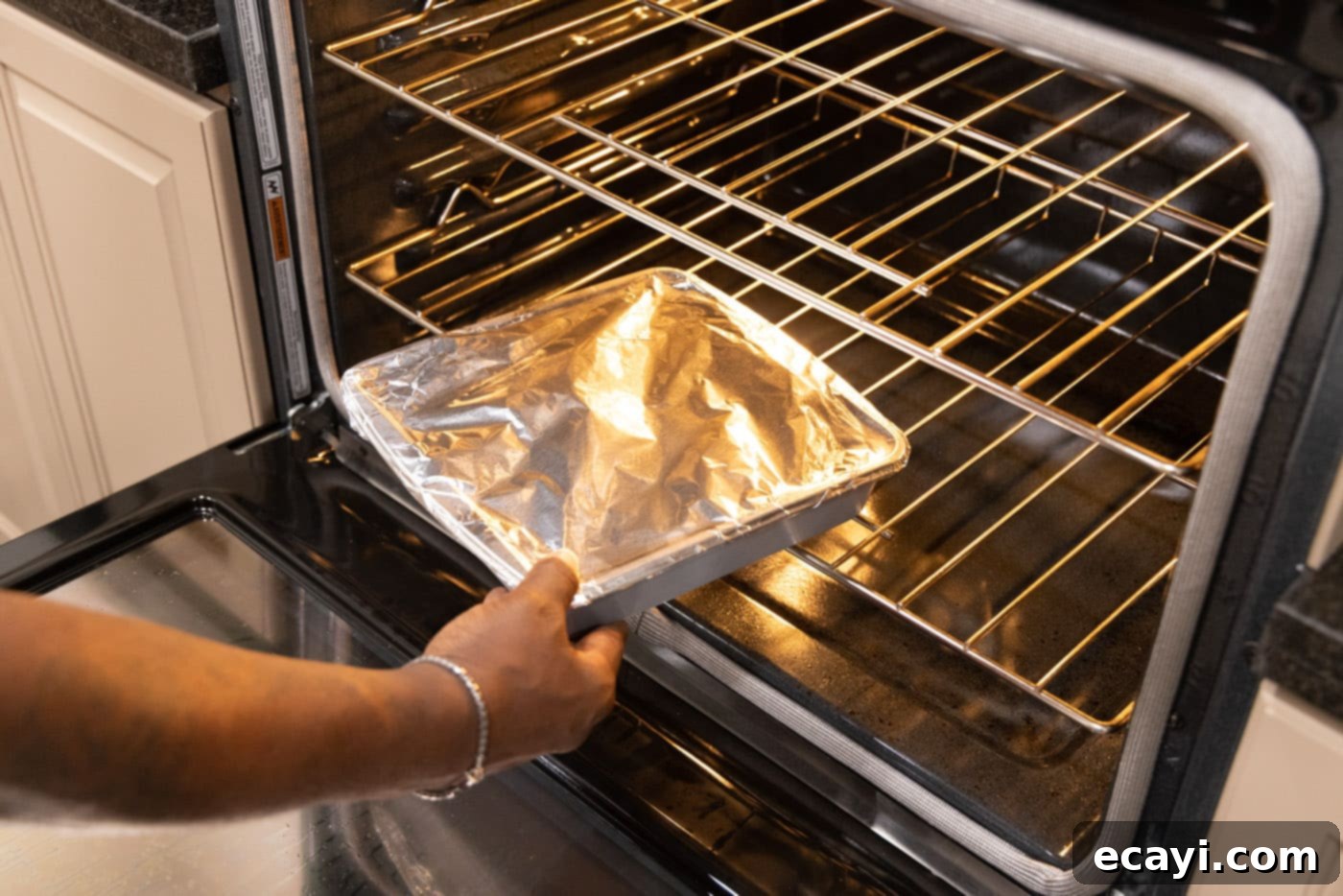Fall-Off-The-Bone Tender Beef Short Ribs: An Effortless 4-Ingredient Oven Recipe
Discover the secret to incredibly tender, melt-in-your-mouth beef short ribs that literally fall off the bone. This recipe demystifies slow-cooked perfection, proving that you don’t need a lengthy ingredient list or complex techniques to achieve extraordinary flavor. With just four simple ingredients and the magic of low-and-slow oven cooking, you’ll create a dish that’s both impressive and remarkably easy. Get ready to savor rich, savory beef that promises comfort in every bite.
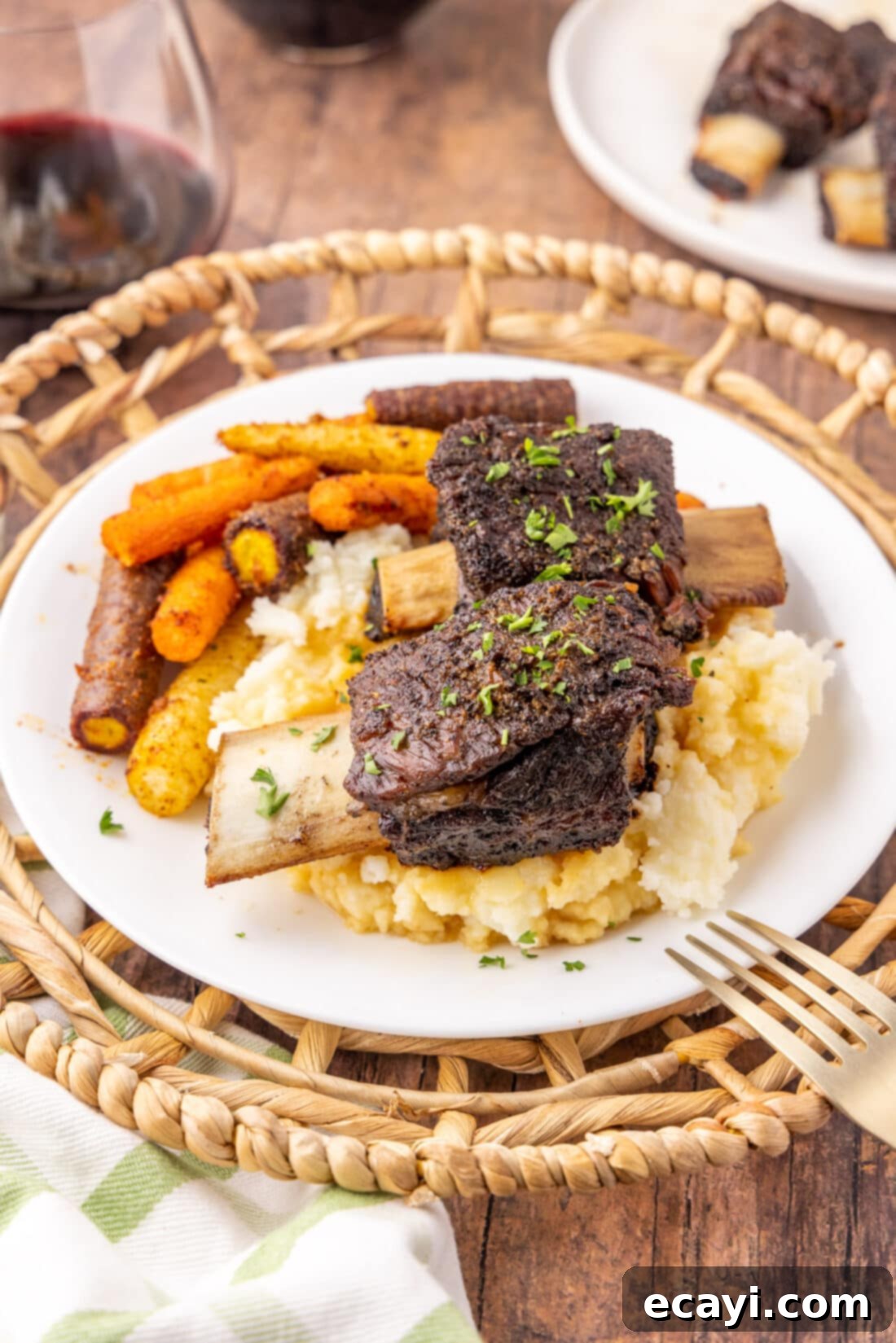
Why This Simple Beef Short Ribs Recipe Works Wonders
This beef short ribs recipe stands out because of its elegant simplicity. It champions the inherent, rich flavor of the beef itself, requiring minimal intervention to shine. Unlike complex braises that call for numerous aromatics and liquids, our approach allows the beef to truly speak for itself. A modest application of garlic salt and pepper is all that’s needed to enhance, rather than overshadow, the deep, savory notes characteristic of high-quality short ribs.
The success of this method hinges on two critical steps: an initial sear followed by a long, gentle bake. First, you’ll give the short ribs a quick stint in a hot skillet, developing a beautiful, caramelized crust. This isn’t just for aesthetics; searing locks in moisture and builds a foundational layer of flavor through the Maillard reaction. This chemical process transforms the surface of the meat, creating hundreds of new flavor compounds that contribute to the overall richness of the dish. Think of it as painting the first stroke of a masterpiece.
Once seared, the ribs are transferred to a baking dish, tightly covered, and slow-cooked in a low-temperature oven for an extended period, typically 3-4 hours. This low-and-slow technique is the true magic behind “fall-off-the-bone” tenderness. Beef short ribs are rich in connective tissue, primarily collagen. High heat would toughen this tissue, but gentle, prolonged heat slowly breaks down the collagen into gelatin. This gelatin then melts into the meat, moisturizing it from within and creating that unparalleled tender, succulent texture that makes short ribs a beloved comfort food. The tight covering ensures that all the moisture released by the meat is trapped, creating a self-braising environment that steams and tenderizes the ribs perfectly.
The beauty of this method is its hands-off nature. After the initial searing, your oven does all the heavy lifting, allowing you to focus on other tasks or simply relax. This makes it an ideal recipe for a weekend meal or a special occasion when you want to impress without being chained to the stove. And for those moments when time is of the essence, we offer a quicker alternative: our Instant Pot beef short ribs recipe, designed to deliver similar tenderness in a fraction of the time. However, for the ultimate depth of flavor and texture, the oven method remains unmatched.
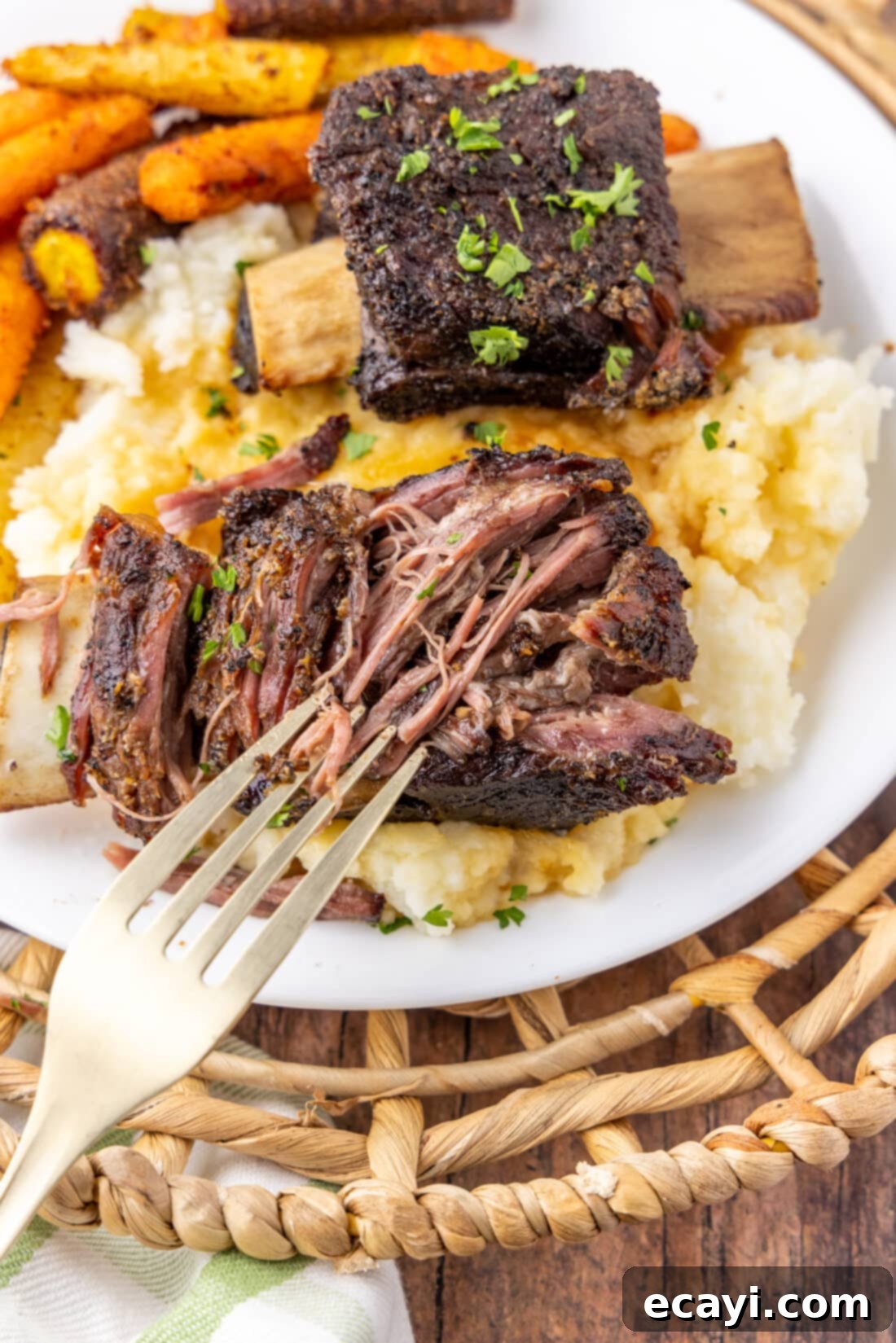
Essential Ingredients for Perfect Beef Short Ribs
One of the most appealing aspects of this recipe is its minimal ingredient list. You only need four items to create a truly spectacular meal. For all precise measurements, detailed instructions, and a convenient printable version of this recipe, please refer to the recipe card located at the end of this post.
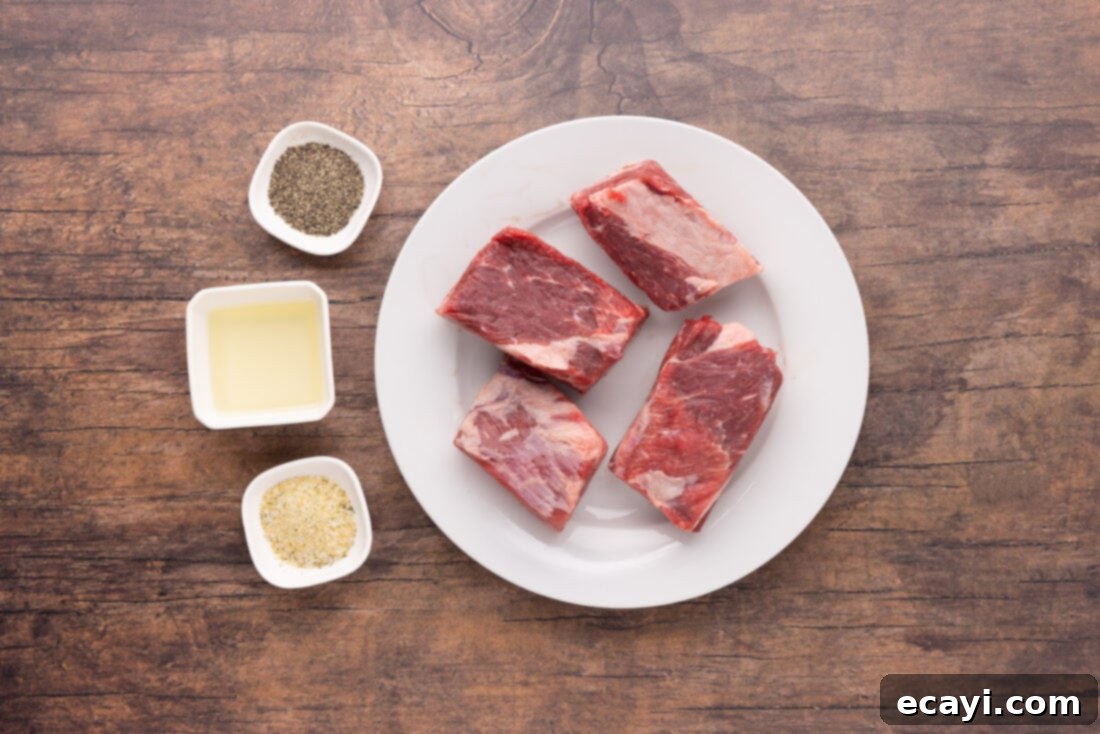
Ingredient Information and Expert Tips
Understanding your ingredients is key to culinary success, even with a simple recipe. Here’s a closer look at what you’ll need:
BEEF SHORT RIBS – The star of our show! Beef short ribs are cut from the chuck primal, making them inherently flavorful due to their rich marbling and connective tissue. You can use either bone-in or boneless beef short ribs for this recipe. Bone-in ribs tend to impart a deeper flavor to the dish, as the bone itself releases marrow and collagen during the long cooking process. Boneless ribs, while equally delicious, offer convenience, especially when serving. Look for ribs with good marbling – streaks of fat throughout the meat – as this fat renders down during cooking, contributing significantly to moisture and flavor. When purchasing, opt for cuts that are uniform in thickness to ensure even cooking. Aim for an internal temperature of 190 – 205°F (88 – 96°C) for truly fall-apart tender results. This temperature range ensures that the tough connective tissues have fully broken down into gelatin, yielding that desirable melt-in-your-mouth texture.
OLIVE OIL – Used to create the seasoning paste and for searing. A good quality extra virgin olive oil can add a subtle fruitiness, but any standard olive oil or even a neutral oil like grapeseed or avocado oil will work effectively for searing and seasoning. Its primary role here is to help the spices adhere to the meat and facilitate browning.
GARLIC SALT – This convenient seasoning combines the savory punch of garlic with the essential salt needed to enhance flavor. It’s an easy way to season evenly. If you don’t have garlic salt, you can substitute with a mix of garlic powder and kosher salt or sea salt. A good starting ratio would be 1 part garlic powder to 2 parts salt, adjusting to your taste. Ensure even distribution for the best flavor.
BLACK PEPPER – Freshly ground black pepper offers the most aromatic and pungent flavor. It adds a gentle heat and depth that complements the richness of the beef beautifully. If you only have pre-ground pepper, that will work too, but consider using a bit less as its flavor can be more intense.
ADDITIONS & VARIATIONS (Optional) – While this recipe thrives on its four core ingredients, the versatile nature of beef short ribs means they can be wonderfully complimented by a variety of other spices and seasonings, should you wish to experiment. Feel free to add the seasonings of your choice to create different flavor profiles. Some popular optional additions include:
- Herbs: Fresh sprigs of rosemary or thyme, tucked into the baking dish, will infuse the ribs with earthy, aromatic notes.
- Spices: A pinch of smoked paprika can add a subtle smokiness and a lovely color. Onion powder can deepen the savory base.
- Braising Liquid: For a richer sauce, you could add about 1 cup of beef broth or even red wine (such as Cabernet Sauvignon or Merlot) to the baking dish before covering. This will create more pan juices, perfect for spooning over mashed potatoes. Keep in mind this would technically add to the ingredient count, but it’s a popular braising method for short ribs. If adding liquid, ensure the liquid only comes about halfway up the ribs, not fully submerging them.
- Tomato Paste: A tablespoon of tomato paste, seared along with the ribs for a minute or two before baking, can add a layer of umami and depth, contributing to a more complex flavor profile.
Remember, the beef short ribs are inherently tender and flavorful thanks to their rich marbling, so any additions should be seen as enhancing, not masking, that natural goodness. Experiment to find your favorite combination!
How to Achieve Perfect Oven-Baked Beef Short Ribs
These step-by-step photos and detailed instructions are here to help you visualize how to make this recipe with confidence. For a convenient, printable version of this recipe, complete with precise measurements and comprehensive instructions, you can Jump to Recipe at the bottom of this page.
- Preheat Oven: Begin by preheating your oven to a low temperature of 275°F (135°C). This crucial low heat setting is essential for slowly breaking down the tough connective tissues in the short ribs, transforming them into succulent, fall-apart tender meat without drying them out. A consistent low temperature ensures gentle cooking, allowing collagen to convert into gelatin over several hours.
- Prepare Seasoning Paste: In a small, clean bowl, combine the olive oil, garlic salt, and black pepper. Whisk these ingredients together until they form a smooth, well-mixed paste. This paste will ensure even distribution of flavor over the ribs and help achieve a beautiful crust during searing.

Olive oil, garlic salt, and pepper being whisked to form a flavorful paste. - Season Short Ribs: Donning a pair of gloved hands (this helps keep your hands clean and ensures hygienic handling of raw meat), generously rub the prepared oil and spice mixture all over the beef short ribs. Ensure every surface of the ribs is thoroughly coated. This step is vital for infusing flavor deep into the meat and promoting a delicious, seasoned crust during searing.

Applying the seasoning mixture evenly onto the beef short ribs. - Sear the Ribs: Place a large, heavy-bottomed skillet (cast iron works wonderfully) over medium-high heat. Allow the skillet to get very hot – you should see wisps of smoke. Crucially, do not add any additional oil to the skillet at this stage, as the ribs are already coated. Carefully place the short ribs into the hot skillet, searing them on all sides to develop a rich, deep brown crust. This process, known as the Maillard reaction, creates incredible depth of flavor and caramelization. Work in batches if necessary to avoid overcrowding the pan, which can steam the meat instead of searing it. Each side should sear for about 2-3 minutes until beautifully browned.

Searing the beef short ribs to create a delicious brown crust. 
Beautifully browned short ribs, ready for the oven. - Prepare for Baking: Line a square baking pan or a casserole dish with heavy-duty aluminum foil, ensuring enough overhang to completely seal the dish. Lightly spray the foil with cooking spray to prevent sticking. Arrange the seared short ribs in the prepared pan in a single layer. Tightly cover the pan with the overhanging foil, crimping the edges securely to create a sealed packet. This tight seal is paramount, as it traps all the moisture released by the meat, creating a self-braising environment that steams the ribs to ultimate tenderness.

Short ribs nestled in a foil-lined baking dish. 
Sealed baking dish going into the preheated oven for slow cooking. - Bake to Perfection: Place the tightly covered pan in your preheated oven and bake for 3 ½ to 4 hours. The cooking time can vary slightly depending on the size and thickness of your ribs. The ribs are perfectly cooked when the meat is incredibly tender and can be easily pulled away from the bone with a fork. For best results, avoid uncovering the pan until at least 3 ½ hours have passed to maintain the internal heat and moisture. If after checking, the ribs aren’t quite tender enough, simply recover them tightly and continue baking for another 30 minutes, checking periodically.
- Rest and Serve: Once tender, carefully remove the pan from the oven. For optimal juiciness and flavor, allow the ribs to rest, still covered, for 10-15 minutes before serving. This allows the juices to redistribute throughout the meat, resulting in a more succulent bite.
Frequently Asked Questions & Expert Tips for Beef Short Ribs
For juicy, fall-apart tender beef short ribs, you’re aiming for an internal temperature higher than typical steak doneness. Target a range of around 190 – 205°F (88 – 96°C). At these temperatures, the collagen and connective tissues in the short ribs have had ample time to break down and convert into rich gelatin, which is what gives the meat its incredible tenderness and succulence. Always use an instant-read thermometer inserted into the thickest part of the meat, avoiding the bone, for an accurate reading.
To maintain freshness and flavor, store any leftover beef short ribs in an airtight container. They will keep well in the refrigerator for 3-4 days. For longer storage, you can freeze them for up to 3 months. When freezing, ensure the ribs are completely cooled, then place them in a freezer-safe bag or container, removing as much air as possible. Thaw overnight in the refrigerator before reheating.
There are generally two main cuts of short ribs: English style and Flanken style. English style are cut parallel to the bone, resulting in a thick, meaty block of beef with a single bone. Flanken style are cut across the bone, producing thinner strips of meat with several small bone segments. For this oven-braised, fall-off-the-bone style, English style short ribs are generally preferred due to their substantial meatiness and higher fat content, which leads to a richer, more tender result. However, boneless short ribs also work wonderfully if you prefer not to deal with bones.
Absolutely! Beef short ribs are an excellent make-ahead dish. In fact, many chefs believe they taste even better the next day, as the flavors have more time to meld and deepen. Cook them according to the recipe, let them cool, then store them in their pan juices (if any, or simply wrapped tightly) in the refrigerator. To reheat, gently warm them in a covered oven at 300°F (150°C) until heated through, or on the stovetop over low heat.
Searing the short ribs before baking is a critical step that should not be skipped. This high-heat, quick cook caramelizes the exterior of the meat, creating a rich brown crust through the Maillard reaction. This process develops hundreds of complex flavor compounds that contribute immense depth and savory notes that simply cannot be achieved through slow cooking alone. It also helps to lock in juices and creates an appealing texture on the outside of the ribs.
This particular 4-ingredient recipe relies on the moisture released from the short ribs themselves, trapped by the tight foil cover, to create a self-braising environment. The fat and natural juices render out, effectively steaming and tenderizing the meat. While traditional braised short ribs often use a liquid like beef broth or wine, this recipe achieves fantastic results without it, keeping the ingredient count minimal. If you desire more pan juices for a gravy or sauce, you can certainly add about ½ to 1 cup of beef broth or water to the pan before covering, but it’s not strictly necessary for tenderness.
Don’t worry! Tenderness in short ribs is a function of time and temperature. If your ribs aren’t fall-apart tender after 3.5-4 hours, it simply means they need a bit more time. Different cuts, oven calibration, and rib thickness can all affect cooking duration. Simply re-cover the pan tightly with foil and return it to the oven for another 30-60 minutes, checking every half hour, until they reach your desired level of tenderness. Patience is key with low-and-slow cooking!
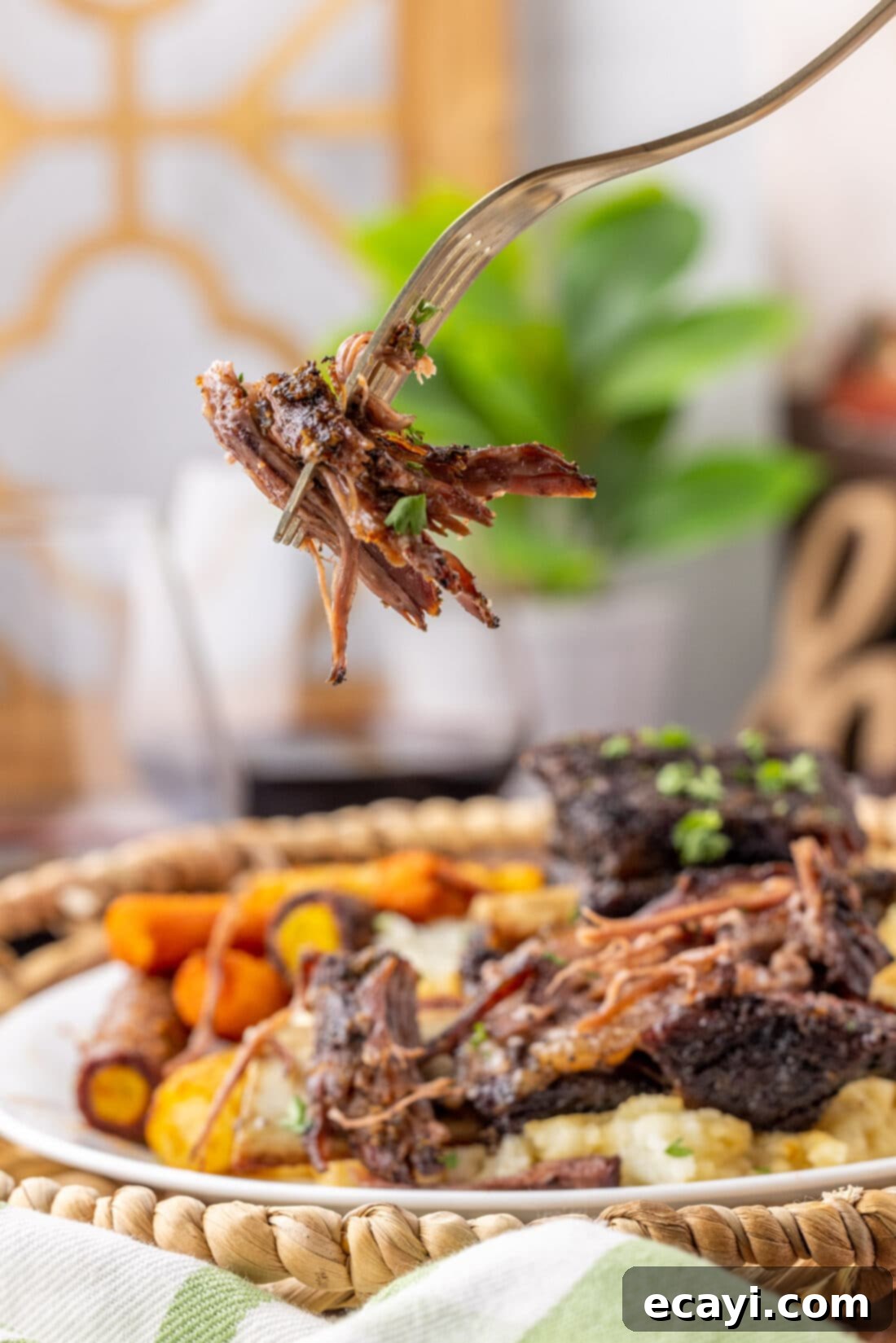
Delicious Serving Suggestions for Beef Short Ribs
These incredibly tender beef short ribs are a hearty, satisfying main course that pairs beautifully with a variety of sides. The rich, savory flavor of the beef means it can stand alone, but complementary side dishes elevate the meal to a truly memorable experience. Here are some fantastic serving suggestions:
- Creamy Mashed Potatoes: The classic pairing! Silky, buttery mashed potatoes are perfect for soaking up any delicious pan juices from the short ribs, creating a luxurious and comforting bite.
- Fluffy Rice: Whether it’s white rice, brown rice, or even a flavorful pilaf, rice offers a neutral base that lets the rich flavor of the short ribs shine. It’s excellent for absorbing savory liquids.
- Roasted Vegetables:
- Roasted Carrots: Their natural sweetness beautifully contrasts the savory beef. Toss them with a little olive oil, salt, and pepper, and roast alongside the ribs (or separately) until tender and slightly caramelized.
- Asparagus: Lightly steamed or roasted asparagus spears provide a fresh, slightly bitter counterpoint that cuts through the richness of the meat.
- Broccoli or Green Beans: Simple steamed or quickly sautéed broccoli or green beans add a vibrant green color and a healthy crunch to the plate.
- Polenta or Grits: For a rustic, Southern-inspired touch, serve the short ribs over creamy polenta or cheesy grits. These absorb the rich flavors wonderfully.
- Crusty Bread: Don’t forget a good loaf of crusty bread to sop up every last drop of the delectable pan juices.
Always enjoy your beef short ribs warm, straight from the oven, allowing their tenderness and aroma to envelop your dining experience. For a fresh finish, consider garnishing with a sprinkle of fresh chopped parsley before serving. This not only adds a pop of color but also a subtle, herbaceous note that brightens the dish.
Explore More Delicious Beef Recipes
If you’ve enjoyed the rich flavors and satisfying experience of these beef short ribs, you’re in for a treat with our other popular beef recipes. Expand your culinary repertoire with these mouth-watering options:
- Perfectly Roasted Beef Tenderloin
- Savory Oven Beef Ribs
- Classic Beef Bourguignon
- Easy Crockpot Roast Beef
- Tender Beef Brisket and Gravy
I love to bake and cook and share my kitchen experience with all of you! Remembering to come back each day can be tough, that’s why I offer a convenient newsletter every time a new recipe posts. Simply subscribe and start receiving your free daily recipes!
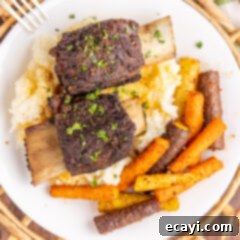
Beef Short Ribs
IMPORTANT – There are often Frequently Asked Questions within the blog post that you may find helpful. Simply scroll back up to read them!
Print It
Pin It
Rate It
Save It
Saved!
Prevent your screen from going dark
Course:
Dinner
Cuisine:
American
2
servings
4 hours
10 minutes
558
Amanda Davis
Ingredients
-
1 ½
pounds
beef short ribs -
½
Tablespoon
garlic salt -
2
teaspoons
black pepper -
2
Tablespoons
olive oil
Things You’ll Need
-
Vinyl gloves -
Large skillet -
Whisk -
8×8 baking pan
or small casserole dish
Before You Begin
- You can use bone-in or boneless beef short ribs for this recipe. Cook to an internal temperature of 190 – 205°F (88 – 96°C) for maximum tenderness.
- Store leftovers in an airtight container kept in the refrigerator for 3-4 days or freeze for up to 3 months.
Instructions
-
Preheat oven to 275°F (135°C).
-
In a small bowl, whisk together the olive oil, garlic salt, and pepper until a paste forms.
-
Using gloved hands, generously rub the oil and spice mixture all over the short ribs, ensuring an even coating on all sides.
-
Preheat a skillet over medium-high heat until hot. Do not add any additional oil. Sear the short ribs on all sides until a nice brown crust develops, about 2-3 minutes per side. Work in batches if needed to avoid overcrowding.
-
Line a square baking pan or casserole dish with heavy-duty foil, leaving enough overhang to create a tight seal. Spray the foil lightly with cooking spray. Place the seared ribs in the prepared pan and cover tightly with the foil, crimping the edges to seal completely.
TIP – Do not uncover the pan until at least 3 ½ hours have passed to keep heat and moisture trapped inside. After checking for doneness, you can recover and continue baking for 30 more minutes if needed.
-
Bake in the preheated oven for 3 ½ – 4 hours, or until the meat is incredibly tender and can be easily pulled away with a fork. Let rest, covered, for 10-15 minutes before serving.
Nutrition
Serving:
1
serving (2 short ribs)
|
Calories:
558
kcal
|
Carbohydrates:
1
g
|
Protein:
48
g
|
Fat:
39
g
|
Saturated Fat:
13
g
|
Polyunsaturated Fat:
2
g
|
Monounsaturated Fat:
21
g
|
Cholesterol:
147
mg
|
Sodium:
1906
mg
|
Potassium:
914
mg
|
Fiber:
1
g
|
Sugar:
0.01
g
|
Vitamin A:
11
IU
|
Calcium:
30
mg
|
Iron:
6
mg
Tried this Recipe? Pin it for Later!
Follow on Pinterest @AmandasCookin or tag #AmandasCookin!
The recipes on this blog are tested with a conventional gas oven and gas stovetop. It’s important to note that some ovens, especially as they age, can cook and bake inconsistently. Using an inexpensive oven thermometer can assure you that your oven is truly heating to the proper temperature. If you use a toaster oven or countertop oven, please keep in mind that they may not distribute heat the same as a conventional full sized oven and you may need to adjust your cooking/baking times. In the case of recipes made with a pressure cooker, air fryer, slow cooker, or other appliance, a link to the appliances we use is listed within each respective recipe. For baking recipes where measurements are given by weight, please note that results may not be the same if cups are used instead, and we can’t guarantee success with that method.
